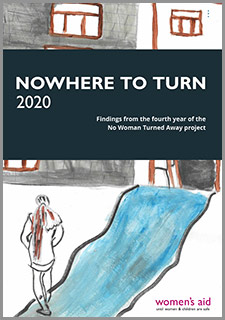
The Domestic Abuse Report 2020 / Nowhere to Turn 2020
- The Domestic Abuse Report 2020: The Hidden Housing Crisis: https://www.womensaid.org.uk/research-and-publications/the-domestic-abuse-report/
- Nowhere to Turn 2020: Findings from the fourth year of the No Woman Turned Away project: https://www.womensaid.org.uk/no-woman-turned-away/
Key findings from reports
The Domestic Abuse Report 2020: The Hidden Housing Crisis examines the housing experiences of survivors of domestic abuse. It draws on evidence from the Women’s Aid Survivor Voice Survey 2019 (136 respondents) and case study interviews. Key findings were:
- Housing concerns represent a significant barrier to leaving an abusive partner.
“I tried to leave a few times…”
Of those 38 respondents who were still in a relationship with an abusive partner, 68.4% indicated that concerns around future housing were a barrier to leaving. Survivors who are not eligible for public funds (because of their immigration status) have even fewer housing options, as they are not entitled to housing-related benefits or for housing help from their local authority.
- Those survivors who were no longer in a relationship with an abuser often felt that the impact of leaving in terms of housing was “…the price I paid for getting out of the terrible relationship.”
This “price to pay” included upheaval (including having to move several times), challenging housing conditions, ongoing abuse, and financial burdens. Private renting was often very difficult or impossible for those survivors claiming housing-related benefits because of the ‘no benefits’ policy adopted by many private landlords.
- Survivors received mixed responses from local housing teams, with some finding that: “It was very difficult to get housed in emergency accommodation.”
Those survivors who had asked their local housing team for emergency accommodation (because of domestic abuse) had received mixed responses. Survivors without dependent children felt that they were a lesser priority to housing teams.
- Friends or family often played a key role in helping survivors with housing: “I am very lucky to have a very supportive family…”
Many survivors had or were still relying heavily on the support of friends or family in terms of a temporary place to stay and/or help with rent or other costs associated with setting up a new home. Survivors living temporarily with friends or family were very grateful for their help, however it was easy for the perpetrator to find them to continue his abuse and living environments were sometimes overcrowded.
Nowhere to Turn 2020: Findings from the fourth year of the No Woman Turned Away project draws on the experiences of survivors of domestic abuse who faced barriers in accessing a refuge space. Specifically, it draws on the experiences of 243 women who were supported by the No Woman Turned Away project between the 12th of January 2019 and the 11th of January 2020. Key findings were:
- The five most common challenges for women seeking a refuge space were:
-
- mental health support needs
- ties to their local area
- disabilities (including mental health disabilities)
- having no recourse to public funds (NRPF)
- fleeing with four or more children
- Almost half of the women (43.2%) supported by the No Woman Turned Away project were from Black and minoritised backgrounds, reflecting the systemic racism that Black and minoritised women face when trying to access places of safety.
- Women who were not able to find suitable refuge accommodation immediately were often forced to live in precarious conditions.
-
- Over a third of the women (38.3%) sofa-surfed and seventeen slept rough whilst waiting for a refuge space.
- Almost a sixth (16.0%) of the women experienced further abuse at the hands of the original perpetrator and at least 15 experienced abuse from an additional perpetrator (of the 180 women who ended their support between the 1st of April 2019 and the 11th January 2020).
- Statutory services offered inconsistent responses.
-
- Of those who contacted a local housing team, 30.8% (32 out of 104) were prevented from making a valid homelessness application.
- Of those who contacted social services, the responsible teams failed to meet their obligation to safeguard women and children in at least 28.6% (18 out of 63) of cases.
- The support from the No Woman Turned Away specialist practitioners was invaluable to survivors of domestic abuse.
Of the women supported by the NWTA specialist practitioners, 24.7% were eventually accommodated in a suitable refuge space.
However, there were inequalities in refuge access depending on the specific barrier that women faced. Women fleeing with an older male child and those with drug use support needs were the least likely to find suitable refuge accommodation.
The full reports are published on our website along with Women’s Aid’s other research and our blog written by the research team.
Women’s Aid Research Team
